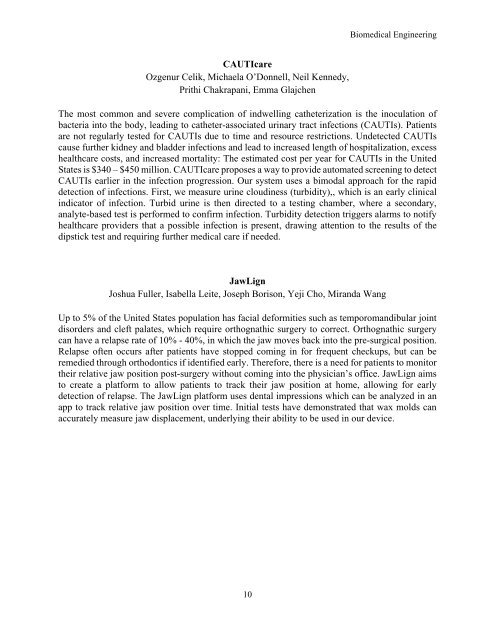Senior Design Expo 2022
Create successful ePaper yourself
Turn your PDF publications into a flip-book with our unique Google optimized e-Paper software.
Biomedical Engineering<br />
CAUTIcare<br />
Ozgenur Celik, Michaela O’Donnell, Neil Kennedy,<br />
Prithi Chakrapani, Emma Glajchen<br />
The most common and severe complication of indwelling catheterization is the inoculation of<br />
bacteria into the body, leading to catheter-associated urinary tract infections (CAUTIs). Patients<br />
are not regularly tested for CAUTIs due to time and resource restrictions. Undetected CAUTIs<br />
cause further kidney and bladder infections and lead to increased length of hospitalization, excess<br />
healthcare costs, and increased mortality: The estimated cost per year for CAUTIs in the United<br />
States is $340 – $450 million. CAUTIcare proposes a way to provide automated screening to detect<br />
CAUTIs earlier in the infection progression. Our system uses a bimodal approach for the rapid<br />
detection of infections. First, we measure urine cloudiness (turbidity),, which is an early clinical<br />
indicator of infection. Turbid urine is then directed to a testing chamber, where a secondary,<br />
analyte-based test is performed to confirm infection. Turbidity detection triggers alarms to notify<br />
healthcare providers that a possible infection is present, drawing attention to the results of the<br />
dipstick test and requiring further medical care if needed.<br />
JawLign<br />
Joshua Fuller, Isabella Leite, Joseph Borison, Yeji Cho, Miranda Wang<br />
Up to 5% of the United States population has facial deformities such as temporomandibular joint<br />
disorders and cleft palates, which require orthognathic surgery to correct. Orthognathic surgery<br />
can have a relapse rate of 10% - 40%, in which the jaw moves back into the pre-surgical position.<br />
Relapse often occurs after patients have stopped coming in for frequent checkups, but can be<br />
remedied through orthodontics if identified early. Therefore, there is a need for patients to monitor<br />
their relative jaw position post-surgery without coming into the physician’s office. JawLign aims<br />
to create a platform to allow patients to track their jaw position at home, allowing for early<br />
detection of relapse. The JawLign platform uses dental impressions which can be analyzed in an<br />
app to track relative jaw position over time. Initial tests have demonstrated that wax molds can<br />
accurately measure jaw displacement, underlying their ability to be used in our device.<br />
10








